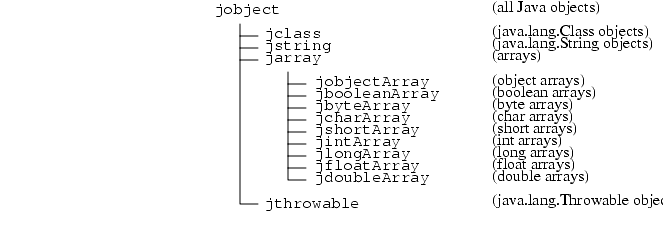
| Contents | Previous | Next | Java Native Interface Specification |
This chapter discusses how the JNI maps Java types to native C types.
Table 3-1 describes Java primitive types and their machine-dependent native equivalents.
The following definition is provided for convenience.
The jsize integer type is used to describe cardinal indices and sizes:
The JNI includes a number of reference types that correspond to different kinds of Java objects. JNI reference types are organized in the hierarchy shown in Figure 3-1.

In C, all other JNI reference types are defined to be the same as jobject. For example:
In C++, JNI introduces a set of dummy classes to enforce the subtyping relationship. For example:
class _jobject {};
class _jclass : public _jobject {};
...
typedef _jobject *jobject;
typedef _jclass *jclass;
Method and field IDs are regular C pointer types:
struct _jfieldID; /* opaque structure */ typedef struct _jfieldID *jfieldID; /* field IDs */ struct _jmethodID; /* opaque structure */ typedef struct _jmethodID *jmethodID; /* method IDs */
The jvalue union type is used as the element type in argument arrays. It is declared as follows:
typedef union jvalue {
jboolean z;
jbyte b;
jchar c;
jshort s;
jint i;
jlong j;
jfloat f;
jdouble d;
jobject l;
} jvalue;
The JNI uses the Java VM’s representation of type signatures. Table 3-2 shows these type signatures.
For example, the Java method:
has the following type signature:
The JNI uses modified UTF-8 strings to represent various string types. Modified UTF-8 strings are the same as those used by the Java VM. Modified UTF-8 strings are encoded so that character sequences that contain only non-null ASCII characters can be represented using only one byte per character, but all Unicode characters can be represented.
All characters in the range \u0001 to \u007F are represented by a single byte, as follows:
|
|
| ||||||
The seven bits of data in the byte give the value of the character represented.
The null character ('\u0000') and characters in
the range '\u0080' to '\u07FF' are
represented by a pair of bytes x and y:
x:
|
|
|
|
| ||||
|
|
|
| |||||
The bytes represent the character with the value ((x &
0x1f) << 6) + (y &
0x3f).
Characters in the range '\u0800' to
'\uFFFF' are represented by 3 bytes x, y, and z:
x:
|
|
|
|
|
| |||
|
|
|
| |||||
|
|
|
| |||||
The character with the value ((x & 0xf)
<< 12) + ((y & 0x3f) <<
6) + (z & 0x3f) is represented by
the bytes.
Characters with code points above U+FFFF (so-called supplementary characters) are represented by separately encoding the two surrogate code units of their UTF-16 representation. Each of the surrogate code units is represented by three bytes. This means, supplementary characters are represented by six bytes, u, v, w, x, y, and z:
u:
|
|
|
|
|
|
|
|
|
|
|
|
|
|
| |||
|
|
|
| |||||
|
|
|
|
|
|
|
|
|
|
|
|
|
|
| |||
|
|
|
| |||||
The character with the value 0x10000+((v&0x0f)<<16)+((w&0x3f)<<10)+(y&0x0f)<<6)+(z&0x3f) is represented by the six bytes.
The bytes of multibyte characters are stored in the
class file in big-endian (high byte first) order.
There are two differences between this format and the standard
UTF-8 format. First, the null character (char)0 is
encoded using the two-byte format rather than the one-byte format.
This means that modified UTF-8 strings never have embedded nulls.
Second, only the one-byte, two-byte, and three-byte formats of
standard UTF-8 are used. The Java VM does not recognize the
four-byte format of standard UTF-8; it uses its own
two-times-three-byte format instead.
For more information regarding the standard UTF-8 format, see section 3.9 Unicode Encoding Forms of The Unicode Standard, Version 4.0.
| Contents | Previous | Next |
Copyright © 2003 Sun Microsystems, Inc. All rights reserved.